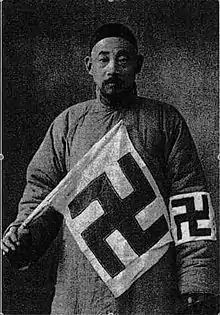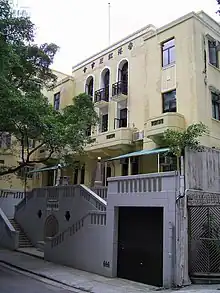世界紅卍字會 | |
 Red Swastika | |
 A Red Swastika Society member, c. 1937 | |
| Formation | 1922 |
|---|---|
| Founder | Du Bingyin (杜秉寅), Li Jiabai (李佳白), Qian Nengxun (錢能訓) |
| Founded at | Mainland China |
| Headquarters | Taiwan |
The Red Swastika Society (simplified Chinese: 世界红卍字会; traditional Chinese: 世界紅卍字會; pinyin: shìjiè hóngwànzìhuì) is a voluntary association similar to Red Cross Society founded in China in 1922 by Qian Nengxun (錢能訓), Du Bingyin (杜秉寅), and Li Jiabai (李佳白). Together with the organisation's president Li Jianqiu (李建秋), they set up their establishment of the federation in Beijing as the philanthropic branch of the Chinese salvationist religion Guiyidao (皈依道), the "Way of the Return to the One".

Spiritual symbol
The swastika (卍 wàn; "infinity", "all") in Chinese and other cultures is a symbol of the universe, or the manifestation and creativity of God. It was one of a number of new transnational world redemptive societies founded in early 20th-century China, drawing upon Western examples such as the Red Cross[1] to build charitable institutions grounded in Asian traditional religions. The use of the symbol in various Asian cultures predates, and is therefore not related to, the symbol's use in Nazi iconography, and the organisation is not associated with the Nazi Party (NSDAP). Reports of its strength during the 1920s and 1930s seem to vary widely, with citations of 30,000 "members" in 1927 to 7–10 million "followers" in 1937.[2]
Mission
Generally, its mission was a broad-based effort of philanthropy and moral education. It ran poorhouses and soup kitchens, as well as modern hospitals and other relief works. It had an explicit internationalist focus, extending relief efforts to Tokyo after earthquakes and also in response to natural disasters in the Soviet Union. In addition, it had offices in Paris, London, and Tokyo and professors of Esperanto within its membership.[3]
Nanjing Massacre

Perhaps its most documented impact on the history of China was for helping the victims of the Nanjing Massacre. The rampage of the occupying Japanese forces through the city left thousands of bodies in the streets, and the Red Swastika Society stepped in to assist in burials. Records of these activities from the Red Swastika Society have provided important primary resources for research into the scale of the atrocity and the location of mass graves.
Present day
Although it seems to have been suppressed during the Maoist rule in mainland China, the Red Swastika Society continues today as a religious organisation focused on charity. It has branches in areas of the Chinese diaspora, with headquarters in Taiwan. Besides charity work, the Red Swastika runs two schools in Hong Kong (Tuen Mun and Tai Po) and one in Singapore (Red Swastika School).
References
- ↑ Pfeiff, Alexandra (2016). "The red swastika society's humanitarian work : a re-interpretation of the red cross in China". New Global Studies. 10 (3): 373–392. doi:10.1515/ngs-2016-0021. ISSN 1940-0004. S2CID 199470483.
- ↑ Duara, Prasenjit (2000). Wen-Hsin Yeh (ed.). "Of Authenticity and Woman: Personal Narratives of Middle-Class Women in Modern China". Becoming Chinese. Berkeley: University of California Press: 348.
- ↑ Duara, Prasenjit (2003). Birgit Meyer; Peter Geschiere (eds.). "Transnationalism in the Era of Nation-States: China 1900-1945". Globalization and Identity. Berkeley: Blackwell Publishers: 51.
External links
 Media related to Red Swastika Society at Wikimedia Commons
Media related to Red Swastika Society at Wikimedia Commons- "The World Red Swastika Society of Taiwan headquarters" (in Chinese).
- "The World Red Swastika Society of Japan headquarters" (in Japanese).